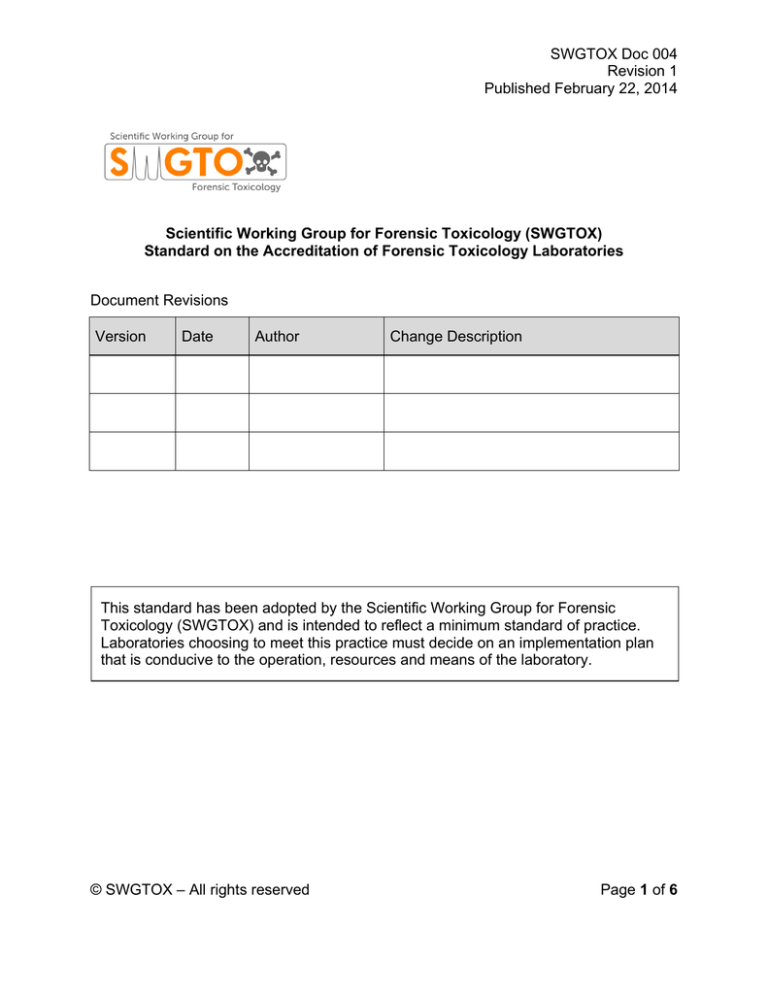
SWGTOX Doc 004
Revision 1
Published February 22, 2014
Scientific Working Group for Forensic Toxicology (SWGTOX)
Standard on the Accreditation of Forensic Toxicology Laboratories
Document Revisions
Version
Date
Author
Change Description
This standard has been adopted by the Scientific Working Group for Forensic
Toxicology (SWGTOX) and is intended to reflect a minimum standard of practice.
Laboratories choosing to meet this practice must decide on an implementation plan
that is conducive to the operation, resources and means of the laboratory.
© SWGTOX – All rights reserved
Page 1 of 6
SWGTOX Doc 004
Revision 1
Published February 22, 2014
TABLE OF CONTENTS
1. Introduction .............................................................................................................. 3 2. Definitions ................................................................................................................ 3 3. Mandatory Accreditation ......................................................................................... 3 4. Basis of Accreditation ............................................................................................. 4 5. Length of Accreditation Cycle ................................................................................ 4 6. Internal Audits .......................................................................................................... 5 7. Scope of Accreditation ............................................................................................ 5 © SWGTOX – All rights reserved
Page 2 of 6
SWGTOX Doc 004
Revision 1
Published February 22, 2014
1.
Introduction
This standard provides specific requirements applicable to the accreditation of
forensic toxicology laboratories and provides direction to all accrediting bodies
working in this field. This standard is focused on the unique requirements of
assessing forensic toxicology laboratories.
2.
3.
Definitions
2.1.
Accreditation – A third party evaluation of a laboratory based on a
particular standard(s), other relevant documents and attestation of a
laboratory’s competence to carry out specific tasks.
2.2.
Analyte – A chemical substance to be identified and/or measured.
2.3.
Assessment – Process undertaken by an accrediting body to evaluate the
conformity, competence and effectiveness of a laboratory based on
particular standard(s) and/or other normative documents and for a defined
scope of accreditation.
2.4.
Forensic Toxicology Laboratory - A facility employing one or more
employees (however named) who perform analytical functions in one or
more sub-disciplines of forensic toxicology.
2.5.
Internal Audit - An audit conducted by the laboratory itself, or on its behalf,
to confirm ongoing compliance with all accreditation requirements.
Mandatory Accreditation
3.1.
Forensic toxicology laboratories must be accredited.
3.1.1.
All sub-disciplines of forensic toxicology provided by the
laboratory that are within the scope of SWGTOX must be
included in the accreditation.
3.1.2.
An accrediting body shall recognize the sub-disciplines listed
below. Each sub-discipline has unique characteristics that must
be assessed. The list excludes programs where mandated,
codified rules and regulations currently exist and are outside the
scope of this standard (e.g., the National Laboratory
Certification Program or the United States Anti-Doping Agency).
© SWGTOX – All rights reserved
Page 3 of 6
SWGTOX Doc 004
Revision 1
Published February 22, 2014
3.1.2.1.
Human performance toxicology (e.g., drug facilitated
crimes, driving under the influence of alcohol or
drugs), including:
3.1.2.1.1. Calibration of instruments for use in
evidential breath alcohol testing.
3.1.2.1.2. Preparation and assignment of
concentration value to reference materials
when the reference material is used to
calibrate an evidential breath alcohol
instrument or to check the calibration of an
evidential breath alcohol instrument.
4.
5.
Postmortem toxicology.
3.1.2.3.
Non-regulated employment drug testing.
3.1.2.4.
Court ordered toxicology (e.g., probation and parole,
drug courts, child services).
3.1.2.5.
General forensic toxicology - other toxicology
performed for a legal purpose in a variety of biological
specimens (e.g., non-lethal poisonings or
intoxications).
Basis of Accreditation
4.1.
An accrediting body must be recognized to ISO/IEC 170111.
4.2.
Accreditation programs offered by an accrediting body must be based on
a relevant ISO standard.
4.3.
Due to the general nature of ISO/IEC 17025 and similar accreditation
standards, accreditation programs must include use of the applicable
SWGTOX standards to appropriately assess forensic toxicology
laboratories.
Length of Accreditation Cycle
5.1.
1
3.1.2.2.
The on-site assessment interval for forensic toxicology laboratories shall
not exceed 2 years regardless of the maximum accreditation cycle allowed
Recognition to ISO/IEC 17011 evaluates the competence of an accrediting body to perform
assessments.
© SWGTOX – All rights reserved
Page 4 of 6
SWGTOX Doc 004
Revision 1
Published February 22, 2014
by the accrediting body. The assessment interval is based on a number of
factors that include but are not limited to: frequency of changes in
technology, method, analyte or matrix.
6.
Internal Audits
6.1.
An accrediting body shall require forensic toxicology laboratories to
conduct an internal audit, at least annually, to ensure continued
compliance with accreditation requirements and the laboratory’s quality
management system.
6.1.1.
7.
Audit records must be maintained for a minimum of 5 years.
Scope of Accreditation
7.1.
Documentation of the awarded accreditation must specify the scope of
services provided by the laboratory and evaluated by the accrediting body.
7.1.1.
The scope of accreditation must state the sub-discipline(s) of
forensic toxicology and the matrix or matrices in which testing is
performed and has been assessed by the accrediting body.
Additionally, the scope of accreditation may also refer to an
analytical technique or a specific test method.
7.1.1.1.
7.1.1.2.
© SWGTOX – All rights reserved
The following matrices are to be considered
separately for the purposes of accreditation:
Urine
Blood and other fluid specimens (e.g., vitreous
humor, serum, plasma, cerebrospinal fluid)
Oral fluid
Tissues (e.g., liver, lung, kidney, brain)
Hair
Gastric content
Meconium
Additional matrices will need to be discussed
between the accrediting body and the laboratory
being assessed.
A laboratory can add capability after method
validation. The laboratory cannot imply that this
Page 5 of 6
SWGTOX Doc 004
Revision 1
Published February 22, 2014
added capability or the reported test result is within
the scope of accreditation until an extension of scope
has occurred.
7.1.2.
The scope of accreditation must state the technology used in
the breath alcohol measuring instrument being calibrated and/or
the type of reference material being certified.
7.1.3.
An accrediting body shall ensure that a forensic toxicology
laboratory does not claim accredited status for any subdiscipline or analytical service that is outside the laboratory’s
scope of accreditation as defined by the accrediting body.
© SWGTOX – All rights reserved
Page 6 of 6
